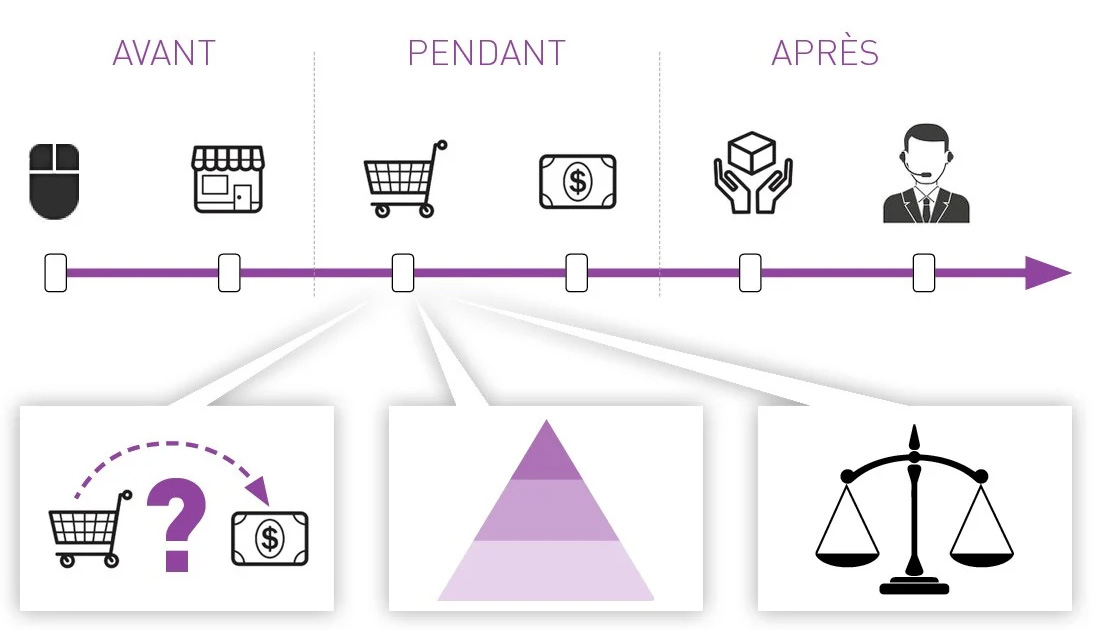Mais par où commencer ? Quelles actions mettre en oeuvre et quels objectifs se fixer ? Découvrez ici (en vision macro) les cinq étapes clés qui vous permettront de concevoir puis déployer un plan d’action efficace pour améliorer le parcours client multicanal.
1. Définissez le périmètre
Pour commencer, pas de plan d’amélioration sans un état des lieux préalable de la situation de départ !
Pour améliorer la qualité de l’expérience délivrée à vos clients, vous devez d’abord mesurer le niveau de qualité actuel et définir le niveau cible attendu.
Le premier travail consiste donc à définir le périmètre du projet, c’est à dire :
-
- les segments de clientèle cibles,
- les étapes du parcours client multicanal que vous souhaitez qualifier en priorité,
- les canaux impliqués.
2. Formalisez le parcours
Une fois toutes ces informations réunies, formalisez les différents parcours client (un pour chaque segment) avec l’ensemble de leurs étapes et points de contact. Vous devez identifier les étapes clés et pouvoir visualiser de façon immédiate et claire sur chacune d’entre elles :
-
- les actions du client, et le canal utilisé pour chacune d’entre elles
- les différents niveaux de besoins (explicites et implicites) des clients
- les choix auquel le client est confrontés et ses critères de choix
Pour tout savoir sur la définition de vos parcours client, (re)lisez notre article : Définir et optimiser votre parcours client.
3. Définissez le référentiel d’Expérience Optimale
Pour chaque étape du parcours client, les actions possibles pour le client et le niveau de réponse apporté
par la marque doivent ensuite être détaillés de façon très précise et évalués selon un système de scoring.
Vous constituerez alors :
-
- votre référentiel d’Expérience Optimale qui décrit l’ensemble des actions pouvant être réalisées pour répondre au mieux aux besoins des clients,
- un guide d’observation qui va permettre d’observer et de noter la qualité de l’Expérience client
4. Mesurez la qualité de l’Expérience délivrée
La mesure de la qualité de l’expérience vécue par les clients peut se faire selon différentes méthodes d’observation, d’analyse et de notation. Pour plus de précisions sur ce thème, nous vous renvoyons à l’article : Savez-vous mesurer l’Expérience Client délivrée par votre marque?
En fonction du contexte, des moyens à disposition, des segments de clientèle étudiés et des canaux analysés, on privilégiera tout ou partie de ces différentes méthodes : observation terrain du parcours client réalisée par les équipes magasin, visites mystère, analyse des statistiques des visites et de la navigation du site internet, analyse des verbatims et avis clients sur le net (réseaux sociaux, forums…) ou encore eyetracking…
Dans tous les cas, les différentes études menées seront finalement consolidées et analysées pour en extraire les notes moyennes attribuées à chaque étape du parcours.
On peut alors réaliser une modélisation du parcours client type de la marque, et déterminer pour chaque étape si l’expérience vécue par le client correspond à :
-
- Un moment déceptif
- Un moment neutre
- Un moment d’enchantement
Les moments clés identifiés lors de la définition du parcours client seront étudiés avec une attention particulière.
Les notes moyennes ainsi établies permettent d’identifier l’écart qui existe entre l’expérience client type offerte par la marque, et l’expérience client cible qu’elle s’est fixée.
5. Optimisez prioritairement les moments clés !
Les écarts identifiés permettent enfin de cibler les points d’amélioration prioritaires. Pour chacun d’entre eux, des préconisations doivent être faites et un plan d’action établi.
Les équipes, mobilisées dès la phase de définition des parcours client, puis sur la phase d’observation, peuvent et doivent également être sollicitées pour la construction des plans d’action en mode « workshop ».
Le déploiement et la mise en œuvre du plan d’action sur les différentes étapes du parcours, pour chaque segment
client et sur chaque canal, nécessite une implication pleine et entière des différentes équipes à chaque stade du projet. La prise de conscience préalable de l’importance des enjeux et de l’impact positif de ces actions est donc d’une importance cruciale.
Découvrez l’ensemble des leviers permettant d’améliorer la performance commerciale : Comment actionner les leviers de la performance commerciale
Et pour aller plus loin, télécharger notre Livre Blanc sur l’ Expérience Client :





